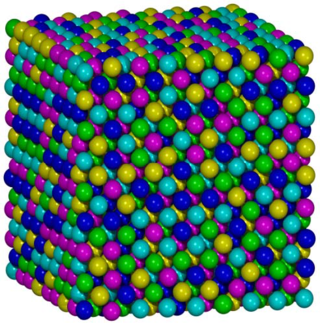
A quasiperiodic crystal, or quasicrystal, is a structure that is ordered but not periodic. A quasicrystalline pattern can continuously fill all available space, but it lacks translational symmetry. While crystals, according to the classical crystallographic restriction theorem, can possess only two-, three-, four-, and six-fold rotational symmetries, the Bragg diffraction pattern of quasicrystals shows sharp peaks with other symmetry orders—for instance, five-fold.

Solder is a fusible metal alloy used to create a permanent bond between metal workpieces. Solder is melted in order to wet the parts of the joint, where it adheres to and connects the pieces after cooling. Metals or alloys suitable for use as solder should have a lower melting point than the pieces to be joined. The solder should also be resistant to oxidative and corrosive effects that would degrade the joint over time. Solder used in making electrical connections also needs to have favorable electrical characteristics.
Aluminium–silicon alloys or Silumin is a general name for a group of lightweight, high-strength aluminium alloys based on an aluminum–silicon system (AlSi) that consist predominantly of aluminum - with silicon as the quantitatively most important alloying element. Pure AlSi alloys cannot be hardened, the commonly used alloys AlSiCu and AlSiMg can be hardened. The hardening mechanism corresponds to that of AlCu and AlMgSi.

An intermetallic is a type of metallic alloy that forms an ordered solid-state compound between two or more metallic elements. Intermetallics are generally hard and brittle, with good high-temperature mechanical properties. They can be classified as stoichiometric or nonstoichiometic intermetallic compounds.
Precipitation hardening, also called age hardening or particle hardening, is a heat treatment technique used to increase the yield strength of malleable materials, including most structural alloys of aluminium, magnesium, nickel, titanium, and some steels, stainless steels, and duplex stainless steel. In superalloys, it is known to cause yield strength anomaly providing excellent high-temperature strength.

A superalloy, or high-performance alloy, is an alloy with the ability to operate at a high fraction of its melting point. Key characteristics of a superalloy include mechanical strength, thermal creep deformation resistance, surface stability, and corrosion and oxidation resistance.
Silver behenate is a silver salt of the long-chain fatty acid behenic acid. It is a possible low-angle diffraction standard that was characterized using the powder diffraction technique.
Nickel aluminide refers to either of two widely used intermetallic compounds, Ni3Al or NiAl, but the term is sometimes used to refer to any nickel–aluminium alloy. These alloys are widely used because of their high strength even at high temperature, low density, corrosion resistance, and ease of production. Ni3Al is of specific interest as a precipitate in nickel-based superalloys, where it is called the γ' (gamma prime) phase. It gives these alloys high strength and creep resistance up to 0.7–0.8 of its melting temperature. Meanwhile, NiAl displays excellent properties such as lower density and higher melting temperature than those of Ni3Al, and good thermal conductivity and oxidation resistance. These properties make it attractive for special high-temperature applications like coatings on blades in gas turbines and jet engines. However, both these alloys have the disadvantage of being quite brittle at room temperature, with Ni3Al remaining brittle at high temperatures as well. To address this problem, has been shown that Ni3Al can be made ductile when manufactured in single-crystal form rather than in polycrystalline form.

Directional solidification(DS) and progressive solidification are types of solidification within castings. Directional solidification is solidification that occurs from farthest end of the casting and works its way towards the sprue. Progressive solidification, also known as parallel solidification, is solidification that starts at the walls of the casting and progresses perpendicularly from that surface.
In materials science, the yield strength anomaly refers to materials wherein the yield strength increases with temperature. For the majority of materials, the yield strength decreases with increasing temperature. In metals, this decrease in yield strength is due to the thermal activation of dislocation motion, resulting in easier plastic deformation at higher temperatures.

Friction stir processing (FSP) is a method of changing the properties of a metal through intense, localized plastic deformation. This deformation is produced by forcibly inserting a non-consumable tool into the workpiece, and revolving the tool in a stirring motion as it is pushed laterally through the workpiece. The precursor of this technique, friction stir welding, is used to join multiple pieces of metal without creating the heat affected zone typical of fusion welding.
Twinning-Induced Plasticity steel which is also known as TWIP steel is a class of austenitic steels which can deform by both glide of individual dislocations and mechanical twinning on the {1 1 1}γ<1 1 >γ system. They have outstanding mechanical properties at room temperature combining high strength and ductility based on a high work-hardening capacity. TWIP steels have mostly high content in Mn and small additions of elements such C, Si, or Al. The steels have low stacking fault energy at room temperature. Although the details of the mechanisms controlling strain-hardening in TWIP steels are still unclear, the high strain-hardening is commonly attributed to the reduction of the dislocation mean free path with the increasing fraction of deformation twins as these are considered to be strong obstacles to dislocation glide. Therefore, a quantitative study of deformation twinning in TWIP steels is critical to understand their strain-hardening mechanisms and mechanical properties. Deformation twinning can be considered as a nucleation and growth process. Twin growth is assumed to proceed by co-operative movement of Shockley partials on subsequent {111} planes.

High-entropy alloys (HEAs) are alloys that are formed by mixing equal or relatively large proportions of (usually) five or more elements. Prior to the synthesis of these substances, typical metal alloys comprised one or two major components with smaller amounts of other elements. For example, additional elements can be added to iron to improve its properties, thereby creating an iron-based alloy, but typically in fairly low proportions, such as the proportions of carbon, manganese, and others in various steels. Hence, high-entropy alloys are a novel class of materials. The term "high-entropy alloys" was coined by Taiwanese scientist Jien-Wei Yeh because the entropy increase of mixing is substantially higher when there is a larger number of elements in the mix, and their proportions are more nearly equal. Some alternative names, such as multi-component alloys, compositionally complex alloys and multi-principal-element alloys are also suggested by other researchers.

Dissimilar friction stir welding (DFSW) is the application of friction stir welding (FSW), invented in The Welding Institute (TWI) in 1991, to join different base metals including aluminum, copper, steel, titanium, magnesium and other materials. It is based on solid state welding that means there is no melting. DFSW is based on a frictional heat generated by a simple tool in order to soften the materials and stir them together using both tool rotational and tool traverse movements. In the beginning, it is mainly used for joining of aluminum base metals due to existence of solidification defects in joining them by fusion welding methods such as porosity along with thick Intermetallic compounds. DFSW is taken into account as an efficient method to join dissimilar materials in the last decade. There are many advantages for DFSW in compare with other welding methods including low-cost, user-friendly, and easy operation procedure resulting in enormous usages of friction stir welding for dissimilar joints. Welding tool, base materials, backing plate (fixture), and a milling machine are required materials and equipment for DFSW. On the other hand, other welding methods, such as Shielded Metal Arc Welding (SMAW) typically need highly professional operator as well as quite expensive equipment.
Nanotech metallurgy is an emerging interdisciplinary domain of materials science and engineering, manufacturing, and nanoscience and engineering to study how nanophases can be applied to significantly improve the processing/manufacturing, micro/nano-structures, and physical/chemical/mechanical behaviors of metals and alloys. This definition was first proposed by Xiaochun Li at the University of California, Los Angeles in 2018, although nanotechnology in metallurgy can be dated back some centuries to the role of precipitates in materials such as Wootz steel and Damascus steel.
Iron aluminides are intermetallic compounds of iron and aluminium - they typically contain ~18% Al or more.
κ-Carbides are a special class of carbide structures. They are most known for appearing in steels containing manganese and aluminium where they have the molecular formula (Fe,Mn)
3AlC.
Aluminium–manganese alloys are aluminium alloys that contain manganese (Mn) as the main alloying element. They consist mainly of aluminium (Al); in addition to manganese, which accounts for the largest proportion of about 1% of the alloying elements, but they may also contain small amounts of iron (Fe), silicon (Si), magnesium (Mg), or copper (Cu). AlMn is almost only used as a wrought alloy and is processed into sheets or profiles by rolling or extrusion presses. These alloys are corrosion-resistant, have low strengths for aluminium alloys, and are not hardenable. They are standard in the 3000 series.
Aluminium–magnesium alloys (AlMg) - standardised in the 5000 series - are aluminium alloys that are mainly made of aluminium and contain magnesium as the main alloy element. Most standardised alloys also contain small additives of manganese (AlMg(Mn)). Pure AlMg alloys and the AlMg(Mn) alloys belong to the medium-strength, natural (not hardened by heat treatment) alloys. Other AlMg alloys are aluminium–magnesium–copper alloys (AlMgCu) and aluminium–magnesium–silicon alloys (AlMgSi, 6000 series).
Aluminium–magnesium–silicon alloys (AlMgSi) are aluminium alloys—alloys that are mainly made of aluminium—that contain both magnesium and silicon as the most important alloying elements in terms of quantity. Both together account for less than 2 percent by mass. The content of magnesium is greater than that of silicon, otherwise they belong to the aluminum–silicon–magnesium alloys (AlSiMg).







